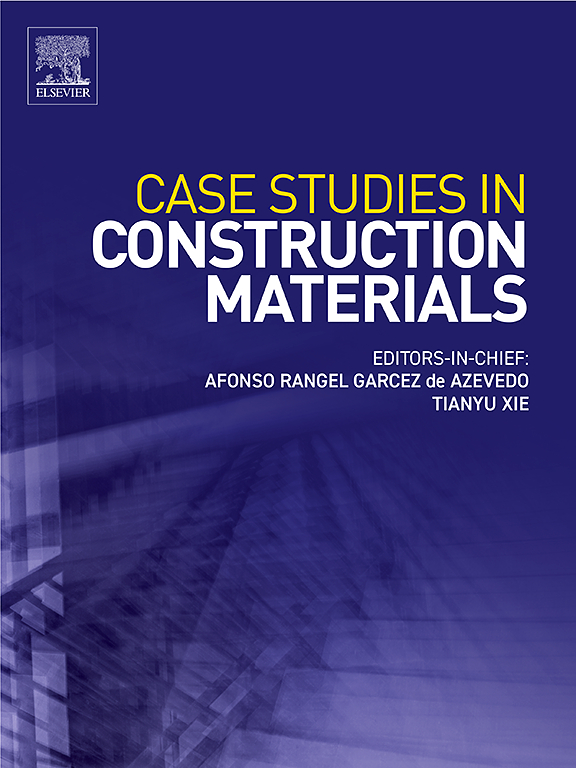Hybrid FRP strengthening of reinforced concrete deep beams: Experimental, theoretical and machine learning-based study
IF 6.5
2区 工程技术
Q1 CONSTRUCTION & BUILDING TECHNOLOGY
引用次数: 0
Abstract
This paper presents experimental findings from testing seventeen reinforced concrete deep beams, categorized into four groups based on the presence and type of openings. A novel and cost-effective hybrid strengthening scheme is proposed comprising glass chopped mat sheets and eco-friendly basalt FRP sheets (GF-BFRP). Group 1 consisted of solid beams without openings, while Group 2 included beams with circular openings, Group 3 with square openings, and Group 4 with rectangular openings of varying dimensions. Each group comprised beams tested in various strengthening configurations using GF-BFRP layers with and without anchor support. Analysis of failure modes revealed initial flexural cracking in control beams, with beams containing openings exhibiting diagonal cracking and reduced shear capacity. Results revealed that beams with openings experienced a significant reduction in shear capacity. Circular, square, and rectangular openings reduced peak capacity by 26.11 %, 30.67 %, and 31.91 %, respectively, while rectangular openings oriented vertically caused the most substantial reduction at 47.46 %. Strengthening using a single GF-BFRP sheet led to debonding, which was mitigated by anchors, enhancing confinement and reducing diagonal cracking. However, strengthened beams did not recover the original strength of the solid beam, which reached a peak load of 245.51 kN. For instance, the C-W1-A beam achieved a peak load of 173.58 kN, which was 4.31 % lower than its control beam due to the extensive anchor installation. Evaluation of predictive models for shear capacity highlighted discrepancies. None of the existing codes provide expressions that account for the shear contributions of externally bonded FRP systems on beams with opening shape and size implicitly defined. To overcome this issue, machine learning approaches were utilized, employing gradient boosting regression and random forest methods. Data on deep beams, both with and without openings (and without strengthening), was collected from eight studies. The models were trained on this dataset, and predictions were made based on the results of this study. While the gradient boosting regression model tended to overestimate the peak capacity of the deep beams, the random forest model provided predictions that were much closer to the experimental results.
混合FRP加固钢筋混凝土深梁:实验、理论和基于机器学习的研究
本文介绍了17根钢筋混凝土深梁的试验结果,根据开口的存在和类型将其分为四组。提出了一种新型的、具有成本效益的混合强化方案,该方案由玻璃切毡片和环保玄武岩玻璃钢片(GF-BFRP)组成。组1为无开口的实心梁,组2为圆形开口梁,组3为方形开口梁,组4为不同尺寸的矩形开口梁。每一组都包括使用GF-BFRP层进行各种加固配置的梁,有和没有锚支撑。破坏模式分析揭示了控制梁的初始弯曲开裂,包含开口的梁显示对角开裂和抗剪能力降低。结果表明,开孔梁的抗剪能力显著降低。圆形、方形和矩形开口分别降低峰值容量26.11 %、30.67 %和31.91 %,而垂直方向的矩形开口降低幅度最大,为47.46 %。使用单个GF-BFRP片材进行加固会导致剥离,锚固可以减轻剥离,增强约束并减少斜向开裂。然而,加固梁并没有恢复实体梁的原始强度,峰值荷载达到245.51 kN。例如,C-W1-A梁的峰值荷载为173.58 kN,由于大量安装锚杆,比控制梁低4.31 %。对抗剪能力预测模型的评估突出了差异。现有的规范都没有提供表达式来解释开放形状和尺寸隐含定义的梁上的外部粘结FRP系统的剪切贡献。为了克服这个问题,使用了机器学习方法,采用梯度增强回归和随机森林方法。从8项研究中收集了深梁的数据,包括有和没有开口(和没有加强)。模型在此数据集上进行训练,并根据本研究的结果进行预测。虽然梯度增强回归模型倾向于高估深梁的峰值容量,但随机森林模型提供的预测更接近实验结果。
本文章由计算机程序翻译,如有差异,请以英文原文为准。
求助全文
约1分钟内获得全文
求助全文
来源期刊

Case Studies in Construction Materials
Multiple-
CiteScore
7.60
自引率
19.40%
发文量
842
审稿时长
63 days
期刊介绍:
Case Studies in Construction Materials provides a forum for the rapid publication of short, structured Case Studies on construction materials. In addition, the journal also publishes related Short Communications, Full length research article and Comprehensive review papers (by invitation).
The journal will provide an essential compendium of case studies for practicing engineers, designers, researchers and other practitioners who are interested in all aspects construction materials. The journal will publish new and novel case studies, but will also provide a forum for the publication of high quality descriptions of classic construction material problems and solutions.
 求助内容:
求助内容: 应助结果提醒方式:
应助结果提醒方式:


